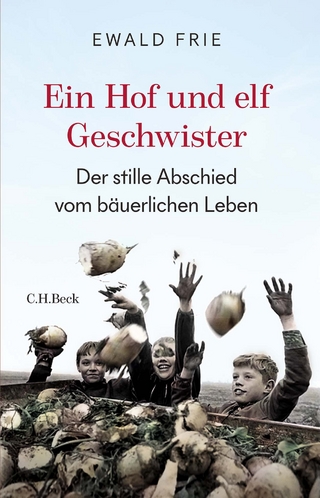
Scythe and the City
Stanford University Press (Verlag)
978-0-8047-9746-7 (ISBN)
Recent historiography has almost completely ignored the ways in which death created such immense social change in China. Now, Scythe and the City corrects this problem. Christian Henriot's pioneering and original study of Shanghai between 1865 and 1965 offers new insights into this crucial aspect of modern society in a global commercial hub and guides readers through this tumultuous era that radically redefined the Chinese relationship with death.
Christian Henriot is Professor of Modern History at Aix-Marseille University and the author of numerous books on modern Chinese history, including Prostitution and Sexuality in Shanghai: A Social History, 1849–1949 (2001). He is also Project Director of Virtual Shanghai (virtualshanghai.net).
Contents and AbstractsIntroduction chapter abstractThe introduction offers various paths on the study of death in China and Europe, while it also sets the stage for the study of death in Shanghai proper.
1Scythe and the City: The Measure of Death chapter abstractThis chapter is an attempt to take the measure of death in the city through the reconstruction of demographic series and a study of the causes of death. It establishes not just the quantitative parameters of death in the city. It also unveils the dramatic condition in which most urbanites lived, their lives and hopes cut short by disease, malnutrition, work conditions, and so on. The chapter demonstrates Shanghai was a gigantic whirlpool that drew its vitality from the masses of migrants that moved into the city.
2Guilds, Charities, and the Community Management of Death chapter abstractThe second chapter examines the role of community organizations, especially the guilds and charities, in the management of death in the city. Up to the 1920s, before the emergence of commercial funeral companies, community organizations were the sole social actors that took care of the disposal of dead bodies. This chapter also studies the earlier forms of regulation by the imperial administration and the foreign municipal authorities.
3Funeral Companies and the Commoditization of the Dead Body chapter abstract. This chapter takes up the new trend commercial funeral companies set in motion from the mid-1920s, when an American company established the first funeral parlor, to the extraordinary boom during the Sino-Japanese War and its problematic legacy, a full-blown ghost city in the midst of Shanghai, in the postwar and early Communist period.
4A Final Resting Place: From Burial Grounds to Modern Cemeteries chapter abstractDue to the particular political and spatial configuration of the city, the space devoted to the final resting place was sharply divided and fragmented. This chapter focuses on the process of transformation of Chinese burial grounds and the rise of modern cemeteries in the twentieth century. It examines the role of private companies in the light of the official prescriptions from the state and the inability of local municipal authorities to respond adequately to social demand.
5Foreign Cemeteries and the Colonial Space of Death chapter abstractThis chapter addresses the specific issue of the colonial space of death that private individuals and communities, but mostly the two foreign municipal councils, created through the establishment and management of cemeteries reserved to foreigners, with only very few exceptions. In pre-1949 Shanghai, foreign cemeteries established a trail of permanent and temporary burial grounds in the core urban area.
6Invisible Deaths, Silent Deaths chapter abstractThis chapter examines the issue of the invisible deaths, those of the most destitute, especially infants and children, whose bodies ended up in back alleys, vacant land, almost everywhere in the city. This was the most gruesome aspect of death as despite its unthinkable magnitude it dissolved under a veil of social invisibility.
7Funerals and the Price of Death chapter abstractDeath had a price. From the performance of funeral rituals, to funeral apparels, and to funeral processions, death (re)created a complete hierarchy in even sharper lines than among the living. Funerals were a central rite of passage in which families invested considerable amounts of money, as much as they could afford, sometimes beyond their means. This chapter provides keys to situate the importance of funeral ceremonies in Chinese death culture and to establish the parameters of inclusion/exclusion of various social groups. It also examines the fundamental issue of the price of death and the economy of death in Shanghai.
8The Cremated Body: From Social Curse to Political Rule chapter abstractEarth burial was the fundamental way of disposing of the dead. Yet other forms emerged, for example, cremation. This chapter is devoted to the introduction of cremation in Shanghai and its slow diffusion until the war made it a compulsory measure to dispose of the unclaimed bodies of the poor. The image of cremation as a curse goes a long way to explain the strong resistance of the population and the cautious approach the authorities took, even after 1950, in promoting it. Yet, by the Cultural Revolution, this had become a standard practice.
9The Management of Death under Socialism chapter abstractAll through the late imperial and Republican period, customs and practices changed along with the emergence of new funeral organizations and the effect of official regulation. Yet the core set of beliefs and practices evolved slowly until the new Communist regime challenged the whole death culture. The final chapter examines the measures through which the CCP took over the control of all organizations involved in the management of death and reorganized drastically the funeral social landscape.
| Erscheinungsdatum | 25.05.2016 |
|---|---|
| Verlagsort | Palo Alto |
| Sprache | englisch |
| Maße | 152 x 229 mm |
| Themenwelt | Sachbuch/Ratgeber ► Geschichte / Politik ► Allgemeines / Lexika |
| Geisteswissenschaften ► Geschichte ► Regional- / Ländergeschichte | |
| Geschichte ► Teilgebiete der Geschichte ► Kulturgeschichte | |
| Geisteswissenschaften ► Psychologie ► Trennung / Trauer | |
| Sozialwissenschaften ► Soziologie ► Mikrosoziologie | |
| ISBN-10 | 0-8047-9746-3 / 0804797463 |
| ISBN-13 | 978-0-8047-9746-7 / 9780804797467 |
| Zustand | Neuware |
| Haben Sie eine Frage zum Produkt? |
aus dem Bereich


